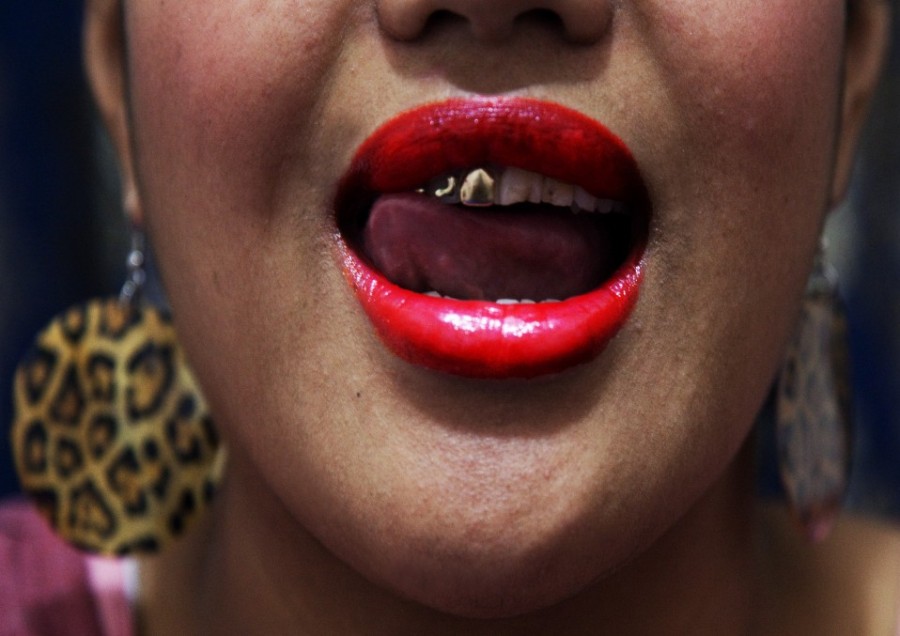Grills
12 February - 3 May 2015
Gallery 8
Free entry
Grills is a recent photographic series and moving image work by artist Ane Tonga that explores the intersection between Tongan notions of beauty defined as faka’ ofo’ ofa and western ideals of beauty. This new work is part of an ongoing photographic investigation that explores nifo koula (gold teeth) as a popular and relatively new form of Tongan body adornment.
Image: Detail, Seta, 2012, photograph by Ane Tonga.
GRILLS
A photographic series by Ane Tonga
Then one tooth after the other was isolated with a non-irritating protective varnish. While protected all four prepared teeth against outside influence with aluminium shells –
“It will feel strange at first when the anaesthesia wears off and your tongue discovers the metal”...
Günter Grass, 1969
Their task...is not to propagate Western culture, but to question its assumptions, to undermine its authority and liberate young people from the ‘structures’.
Roger Scruton, 1998
How is culture constructed and maintained and passed on to the next generation?
It is easy to use superficial readings of a person’s physical body and construct it in our own heads. We read skin colour, hairstyle, whether one wears glasses or whether one has blonde hair or dangly earrings etc. and make value judgements all the time. Though identity is supposedly fluid, the common practices of communities tend to become fixed identifiers by which we (rightly or wrongly) differentiate one cultural group from another. In among the various Pacific cultures, it does appear to have become more of a Tongan phenomenon to adorn the mouth with pure gold. By their teeth ye shall know them...
You can tell what they are by what they do.
Matthew 7: 16
The Contemporary English Version of the Bible
Ane Tonga‘s photographic series at first glance is purely about the grills/nifo koula allusion. There is an implicit strategic essentialism at work in these images. Tonga’s work employs the word Grills as a titular hook. It is the conceptual artifice that makes us look unwittingly at the entire phenomenon of nifo koula as a practice peculiar to Tongan cultural adornment. Nifo koula, the gold adornment of teeth, is a fairly recent trend in Tongan contemporary culture. Aesthetically, it assumes a similar role to that of grills (teeth adornment) that rose in popularity within (but not exclusive to) black American hip-hop culture. Grills immediately speaks of hip-hop culture and minority status.
Body adornment in almost every culture signifies much more than decoration. Conscious decisions are made when adding to and adapting the body. Traditional tattoo and mehndi application (henna) practices for instance are ways of decorating the body that have existed for centuries. While these practises are part ritual and part adornment, nifo koula is more of choice with no formal rite of passage attached to its acquisition.
While the nifo koula is the central thematic and the imagery is focused around the mouth only, Tonga’s works presents us with much more than gold, teeth and gums.
Representations of the mouth, especially in Western advertising and visual arts are often afforded a place somewhere near the top of the hierarchy of signifiers of soft eroticism.
Tonga (the artist) addresses the sexual politics of representation of the mouth as a symbol of allure - shiny and naturally full red lips and a tongue in mid-swill (Seta) - this is sexually suggestive, which subverts the modern construction of Polynesian modesty since ‘Christianity’ insisted that islanders cover up in the late eighteenth century . Tonga’s visual strategy obscures the facial details in order to maintain the subjects’ privacy whilst simultaneously exposing quite intimate images of them in a very public setting. In doing so, she attempts to redress the absence of the brown body in contemporary art, film, media and advertising contexts. The unpretentious false teeth in a glass of water (Nan) and full jubey lips of the younger women expose the nifo koula readily for the artist because she is known to them. It is likely these images may not have been possible were they strangers to the person behind the lens. The artist introduces the political element in her documentation of teeth-adornment in this context: she presents a counter-strategy to the mainstream European bee-stung lips touted /pouted as ideal beauty that renders otherness invisible and less appealing. American hip-hop grills as well as full Polynesian lips effortlessly transgress the conventions of beauty that is either fashion or Hollywood-driven.
These are women with close ties to the artist, they are not just subject matter; they truly matter. They form a visual matrilineal passage that leads to their homeland of the Kingdom of Tonga. Tonga’s (the artist) photographic images of the mouths of her mother and cousins and grandmother pull the viewer in; what the viewer sees is not just mouths with gold but a vision of modern Tonga itself.
In its very conception, these are Tongan works by a Tongan woman. They are statements of assertion of the ‘other’ in the discourse of contemporary art practice. Each of the mouths with gilded teeth is eloquent, beautiful, erotic and tapu.
It’s Grills by Ane Tonga, not Grillz by Nelly.
Nofo a!
Leafa Wilson
Curator (Art)
Waikato Museum Te Whare Taonga o Waikato
2015

